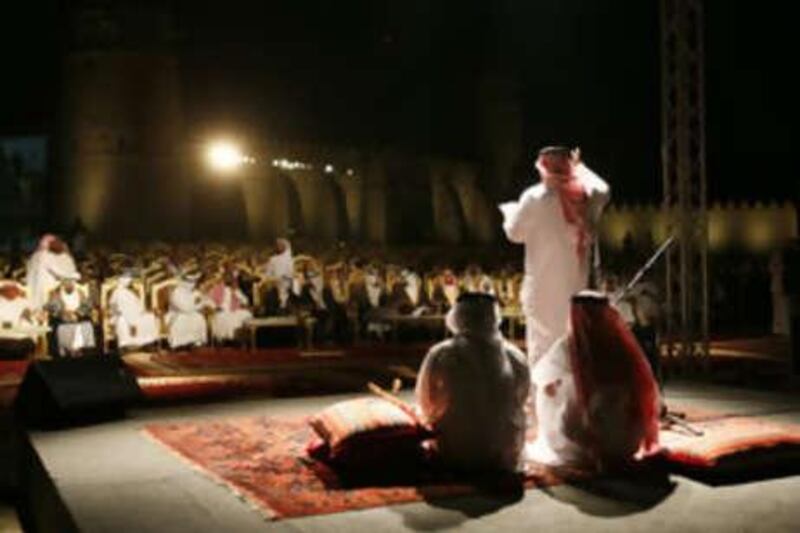AL AIN // Al Jahili Fort, the former summer residence of the Abu Dhabi Royal Family, was reopened last night after almost two years of renovations, amid traditional dancing, singing and poetry. The fortress, one of the oldest buildings in the UAE's garden city of Al Ain, was officially reopened by Sheikh Sultan bin Tahnoon, the chairman of Abu Dhabi Authority for Culture and Heritage (Adach). The ceremony included a performance of the mesmerising traditional Emirati dance, the Ayala.
Built in 1898 by Sheikh Zayed the First, the building is a landmark of the city and has been carefully renovated using traditional mud blocks, mud plaster and palm logs, and re-using existing historic building materials where possible. Al Jahili is the first fort to be restored in Adach's plan to preserve the nation's historic bastions for future use and it will be open to the public without charge. It is hoped the building, the largest of Al Ain's mud-brick forts, will once again become a gathering place for the community.
"The purpose is not just to conserve but also to find new uses for these buildings," said Dr Sami el Masri, the director of strategic planning at Adach. "We hope Al Jahili Fort will become a cultural destination." One of the highlights of the development is a permanent exhibition about Wilfred Thesiger, the British explorer and writer who spent years exploring the Rub al Khali, or Empty Quarter, in the 1940s with his Bedouin companions, a period he later called "the five happiest years of my life".
Through excerpts of his writing and his own photos, the exhibition throws light on the man who fell under the spell of the desert. Bin London and Freedom of the Desert tracks Thesiger's life from his early years in Africa to his experiences with the marsh Arabs of Iraq, and includes copies of the clothes and equipment he used on his desert travels. Thesiger would dress like the Bedouin, with a traditional Omani kanjar around his waist and cartridge belt strapped across his chest, carrying his compass and Leica camera in a goatskin bag.
A close friend of Sheikh Zayed, Thesiger visited Al Ain and enjoyed hunting and exploring on nearby Jebel Hafit. When visiting the city he stayed with Sheikh Zayed at Al Muwaiji Fort, although photographs found while researching the exhibition show he also visited Al Jahili. "We chose Thesiger because it relates the character and hospitality of the people," Dr el Masri said. "Thesiger came here and was accepted by the Bedouin tribes. It shows the openness of the society."
The fort also houses an information centre and a temporary exhibition space in the west wing, which will be used for up to 20 exhibitions a year and is hoped to cement the venue's position as a cultural centre. An audio-visual display on the history and development of the city of Al Ain will be added in the fort's round tower in May next year. Visitors will walk through a series of rooms, discovering a different theme in each. Animation, music, poetry and special effects evoking trickling water and cooling breezes will all be used to bring Al Ain's past to life.
The fort had fallen into disrepair by the early 1950s, when British forces came to Al Ain and requisitioned it as a base. Barracks and other buildings were added within a new enclosure. The building has an inner square fortress surrounded by an outer wall and a large, distinctive corner turret with four concentric levels or terraces. The oldest parts of the site are the inner fort and the separate, multi-tiered round tower, which may have originally been a single watchtower built to guard the oasis from raiders. A project to gather oral histories from local people and former soldiers is also under way.
"We want to make that kind of information more available," said Bill Evans, the information systems manager. "We are collecting everything of cultural interest." David Neild, a former British colonel, is one of those with a story about the fort. In the eight years he served with the Trucial Oman Scouts he was often based at Al Jahili and spent his 21st birthday in the tower in 1959. Mr Neild returned for his 70th birthday four days ago.
"It was really very special," he said. "There have been a lot of changes over the years but it's good that the building is getting the recognition it deserves." lmorris@thenational.ae






